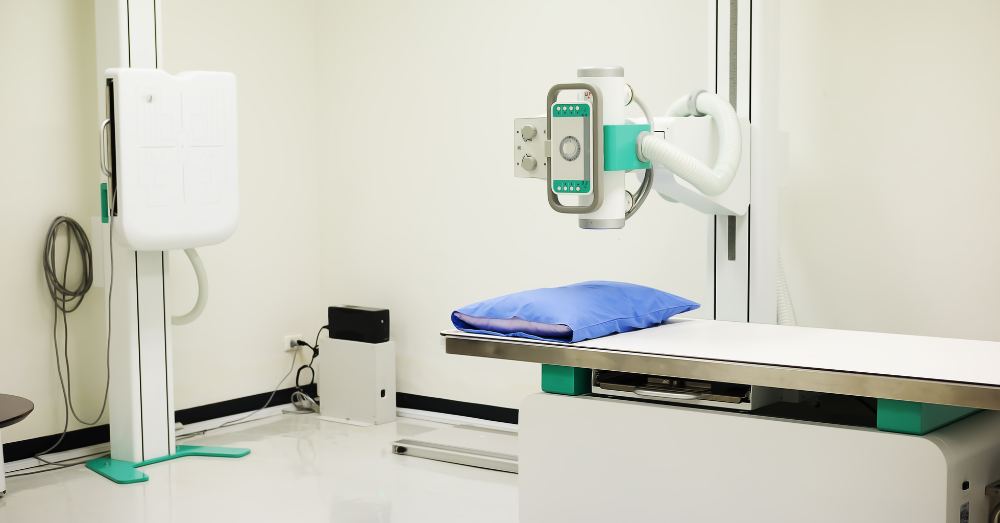X-ray machines are essential tools in a wide range of fields, from medicine and veterinary medicine to industry and scientific research. With their ability to penetrate solid materials and provide detailed images, these devices are used for medical diagnosis, industrial quality control and other specialized applications.
However, the use of ionizing radiation requires stringent safety measures, particularly to protect personnel and the public from harmful exposure.
This article explores the areas of use of X-ray machines , analyzing the reference regulations, the installed power and the shielding solutions adopted, such as lead and high-density concrete . We will also provide a detailed overview of the protections required, including the veterinary and industrial sectors , where these technologies play a crucial role.
Areas of Use of X-ray Machines

X-ray machines are used in a variety of industries , with specific applications and machines designed for different needs.
- Medical and healthcare sector:
- Diagnostic X-rays: Used to visualize bone structures and soft tissues. Machines operate at powers between 50 kV and 120 kV, ideal for thoracic, orthopedic and neurological examinations.
- Computed Tomography (CT): Produces high-resolution three-dimensional images, using radiation up to 140 kV.
- Fluoroscopy: Allows real-time visualization during surgical procedures. Power ranges from 70 kV to 120 kV.
- Mammography: Machines with low doses of radiation (up to 35 kV) for the examination of breast tissue.
- Veterinary sector:
- X-ray machines are widely used for diagnostics in small and large animals.
- X-rays for small animals (dogs, cats, rabbits): The machines operate between 40 kV and 90 kV.
- Large animal radiography (horses, cattle): Power levels range between 80 kV and 120 kV, which are necessary to examine bones and joints of large animals.
- Industrial sector:
- Industrial Radiography (NDT) : Used for non-destructive inspection of materials, machines operate at powers ranging from 150 kV to over 1 MV.
- Gamma irradiation sterilization: Used to sterilize medical devices and foods. Typical energy is between 1 MeV and 2 MeV.
Reference Regulations
European and Italian legislation imposes rigorous standards for the use of ionizing radiation. Directive 2013/59/Euratom establishes the basic safety standards, which in Italy have been implemented by Legislative Decree 101/2020. The law regulates:
- Exposure limits for workers and the public.
- Shielding requirements for radiological, industrial and veterinary rooms.
- Certification of installations by radiation protection experts, who determine the thickness of the shielding material.
Installed Power
The power of X-ray machines varies greatly depending on the context:
- Medical equipment: Diagnostic X-rays operate between 50 kV and 120 kV, while CT scans can reach 140 kV. Mammograms use low power, up to 35 kV.
- Veterinarians: Small animal radiographs operate between 40 kV and 90 kV, while for large animals they can reach 120 kV.
- Industrial Plants: NDT machines for industrial radiography can use powers above 1 MV, ideal for large-scale structural inspections.
Types of Protection Adopted: Lead or Cement
To avoid health risks, facilities that house X-ray machines must be adequately shielded. The type of shielding depends on the power of the machine and the environment in which it is used.
- Lead:
- It is the most used material for shielding due to its high density and ability to block radiation.
- Medical X-rays: X-ray rooms require lead thicknesses between 1mm and 3mm.
- Industrial and Veterinary X-rays: Require higher thicknesses. Industrial facilities may require over 5mm of lead , while veterinary rooms may be shielded with 1.5mm to 2mm of lead.
- High Density Cement:
- The concrete is used in radiotherapy rooms or in high-energy industrial applications, where thicknesses can reach 30-50 cm.
- For industrial radiology or gamma ray sterilization rooms, concrete thicknesses greater than 50 cm are used.
Detailed Technical Table
Hospital sector

Industrial Field

Dental Studies

To ensure the safety of the facilities, it is essential to install the right shielding. In radiology rooms, protection with lead or high-density concrete is mandatory, as specified by current regulations. In the veterinary sector, X-ray machines require protections similar to those used in human healthcare , with the difference that the powers used may vary depending on the size of the animals.

If you are looking for solutions to protect your facilities from radiation, RX lead doors are a fundamental choice to ensure safety . The doors are designed to effectively shield radiation, integrating high quality lead ranging from 1 mm to over 3 mm thick, depending on the specific needs.
Visit the RX lead door collection to find customized solutions, ideal for dental offices, veterinary clinics and industrial facilities.
Important note: This article is for informational purposes only. The shielding solutions described must be designed and defined by a competent radiation protection engineer, in accordance with current regulations. We assume no responsibility for the correct installation or design of shielding for the use of X-ray machines.

